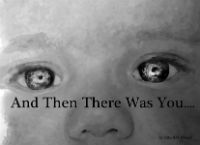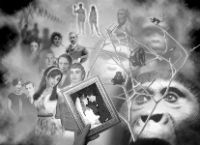And Then There Was You…: A Children's Story of Science and Emotion
Almanac: Evolution: A Big History Perspective
This essay describes the background to the writing of the children's book ‘And Then There Was You...’ In addition, the multiple layers of the story that go beyond a child's initial comprehension are deconstructed. The book in question hits upon many of the themes of the Big History movement in academia.
 And Then There Was You... (2010a, 2010b) is a story about everything. It was a story written and illustrated for my son about 6 months after he was born. One sleep-deprived night I nursed him in a rocking chair while pondering the design of his room. I had decorated the top half of the room with Maxfield Parrish-styled clouds and a layout of the summer constellations set in glow-in-the dark paint on the ceiling. I wanted this design to say: ‘the future is wide open’ and ‘there is nowhere else to go but up’. The border of the room had wall paper that was a replica of a Victorian time-chart of all of human history. It started with Adam and Eve and was up-dated with the on-goings of the present day. Staring into my son's eyes, I pondered all of the events that had to take place for all of his atoms to be aligned into his tiny form. That is when I decided to write and illustrate a children's book that accidentally hit upon all of the major themes contained in ‘Big History’.
And Then There Was You... (2010a, 2010b) is a story about everything. It was a story written and illustrated for my son about 6 months after he was born. One sleep-deprived night I nursed him in a rocking chair while pondering the design of his room. I had decorated the top half of the room with Maxfield Parrish-styled clouds and a layout of the summer constellations set in glow-in-the dark paint on the ceiling. I wanted this design to say: ‘the future is wide open’ and ‘there is nowhere else to go but up’. The border of the room had wall paper that was a replica of a Victorian time-chart of all of human history. It started with Adam and Eve and was up-dated with the on-goings of the present day. Staring into my son's eyes, I pondered all of the events that had to take place for all of his atoms to be aligned into his tiny form. That is when I decided to write and illustrate a children's book that accidentally hit upon all of the major themes contained in ‘Big History’.
I wanted my son to have a firm grounding in understanding where he came from. My quandary was where to start. There was always something that came before. I had no choice but to start at the utmost beginning – the Big Bang. Out of blackness, came something. It was binary. On or off. Either something existed or it did not. I was about to shove the deepest arguments that some of the world's best philosophers, thinkers and theologians could come up with into a children's book.
The first page I illustrated was black with a white hot explosion in the middle, captioned by the solitary word: ‘Spark!’ It does not answer any questions, it only creates them. The reader will have the rest of their life to ponder that one page. Is it simply the mechanical spark that created the Big Bang? Where did it come from? What, if anything, came before it? Or is the spark divine? It works either way depending on the reader.
After illustrating the formation of our solar system and our planet, the spark returns again. This time the spark is in the form of lightning and it is setting off the chain of events involved in starting life with the raw materials of carbon, water and various molecules and amino acids. One-celled organisms are illustrated, followed by a jump in the timeline to the time of the dinosaurs. This is my son's favorite part, and it causes him to roar.
Life occasionally has die-outs though, so the Cretaceous-Tertiary event is depicted with a giant meteor heading for the Gulf of Mexico. A small, fuzzy mammal survives, looking a bit traumatized. Life recovers and is represented as a phylogeny that is constructed out of photo-montages. This family tree starts with one-celled organisms and leads up to one of the highest branches, showing a man and a woman looking much like the ones etched on the side of the Voyager 2 satellite.
The rise of humanity is ignited with another spark. I photo-manipulated an image of my own hands to look like the dirty and weathered hands of presumably a Homo habilis smashing flint together and making a spark for fire. Language, writing and farming images segway into a map that explains the human diaspora out of Africa and the rise of human civilization.
A new phylogeny image morphs into a large family tree by the next page, displaying a variety of primates and the generations leading up to one family and one union. The final page combines science and emotion in the form of a sleeping baby. One is left to ponder all of the steps that had to go right in order for that one little life to exist. Life is complex. I want my son to understand that. There are books out there, such as Of Pandas and People: The Central Question of Biological Origins (Davis and Kenyon 1993), and then there were the school board hearings in Topeka, Kansas, which espoused the idea that evolution is too complex to be true. Evolution is complex, beautiful and profound, as well as mostly accidental and logical. Once one understands that, then the natural world makes sense.
Needless to say, this children's book has many layers that adults will enjoy. Children, however, will be dazzled by the images and – with the help of their parents – it can help explain where they came from. ‘Where did I come from?’ It is not an easy question to answer if you want to be accurate and thorough. I remember playing the question-game, ‘What came before that?’ with my mother. The poor woman was exhausted by the endless questions, but she made her best effort to answer them!
 I hope that my son will cherish the keepsake I created for him. I used my talents of graphic design, photography and photo manipulation to create the story that I self-published for him. I even photoshopped snippets of images from the zoo, pictures of him, pictures from our back yard and images of his ancestors into the piece. I hope he tells his grandchildren about these ‘Easter eggs’ that I left behind for him to search for. The book lays the ground work for understanding the world, along with a fascination for science and, potentially, philosophy. There is truth in both art and science, and I hope I included some of it.
I hope that my son will cherish the keepsake I created for him. I used my talents of graphic design, photography and photo manipulation to create the story that I self-published for him. I even photoshopped snippets of images from the zoo, pictures of him, pictures from our back yard and images of his ancestors into the piece. I hope he tells his grandchildren about these ‘Easter eggs’ that I left behind for him to search for. The book lays the ground work for understanding the world, along with a fascination for science and, potentially, philosophy. There is truth in both art and science, and I hope I included some of it.
Davis P., and Kenyon D. H. 1993. Of Pandas and People: The Central Question of Biological Origins. 2nd ed. Dallas: Haughton Pub Co.
Gronek E. 2010a. And Then There Was You... San Francisco: Blurb.com.
Gronek E. 2010b. And Then There Was You... Raleigh (North Carolina): Lulu.com.
